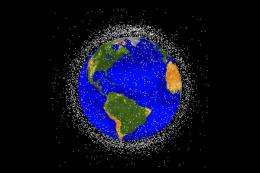Tiny bits of debris are a big problem in space, says Stanford professor in report on 'space junk'

Many of us have too much junk shoved into our closets, but according to a report released Friday by the National Research Council, we Earthlings also have way too much junk orbiting our planet – and it is becoming a serious hazard.
Space debris – remnants of various human-made spacecraft, along with naturally occurring material, or meteoroids, shed by passing asteroids and comets – are threatening satellites and other spacecraft, as well as astronauts.
According to the U.S. Air Force, which is responsible for detecting and tracking human-made objects orbiting the Earth, at any given time there are somewhere in the neighborhood of 22,000 pieces of debris 10 centimeters or larger zipping along in orbit at speeds of seven kilometers per second.
Objects that large, moving that fast, can do serious damage to anything they hit. But Sigrid Close, an assistant professor of aeronautics and astronautics at Stanford, says there are billions of much tinier particles that can – and do – damage spacecraft, at roughly once per year – a number larger than that associated with space debris.
Close was a member of the 13-person panel that produced the report. She and Peter Brown, a professor of astronomy at the University of Western Ontario, wrote the section on meteoroids.
Meteoroids come in all different sizes, but most are usually tiny – weighing on the order of a billionth of a gram or less and measuring less than one five-hundredth of an inch – and Close has been studying them for years.
"One of the issues we raised was that everyone is focused on the impacts of the larger particles and nobody is looking at the mechanism for electrical failures and anomalies associated with small, fast particles, even though it appears as though this is how satellites are failing," Close said.
"This would occur from very fast-moving particles and could happen from particles as small as a nanogram. Why are spacecraft having anomalies during high-speed meteor showers?" The committee report recommended that NASA take the problem seriously.
Ivan Linscott, a senior Stanford researcher with Close's team, recently ran an experiment to try to detect radio frequency emission from plasmas, which are produced when a meteoroid or debris particle hits a spacecraft. Stanford Graduate students Theresa Johnson in aeronautics and astronautics and David Strauss in electrical engineering worked with Linscott. Their preliminary results suggest that radio frequency emissions are indeed produced when a particle weighing less than a billionth of a gram and traveling upward of 20 kilometers per second smacks into a spacecraft and produces ionization.
"Now the question is, what is the mechanism behind this? Can these radio frequency emissions cause a satellite to fail or cause an anomaly on the satellite even when you never see a momentum transfer?" Close asked.
In other words, can a particle too tiny for its impact to be felt by a spacecraft still cause the spacecraft to malfunction?
That may sound like a question along the lines of, "If a tree falls in a forest and no one is around to hear it, does it make a sound?" But the answer to the meteoroid question has more than just philosophical implications, as the multibillion-dollar satellite and spacecraft industry and NASA know all too well. Stay tuned for Close's further results.
Provided by Stanford University




















